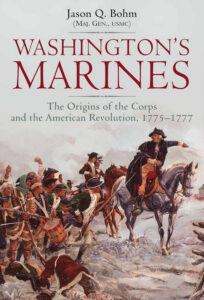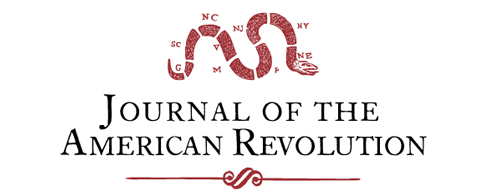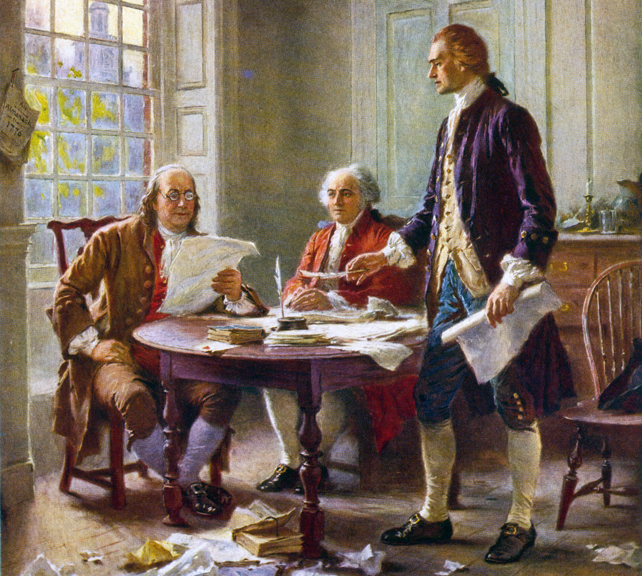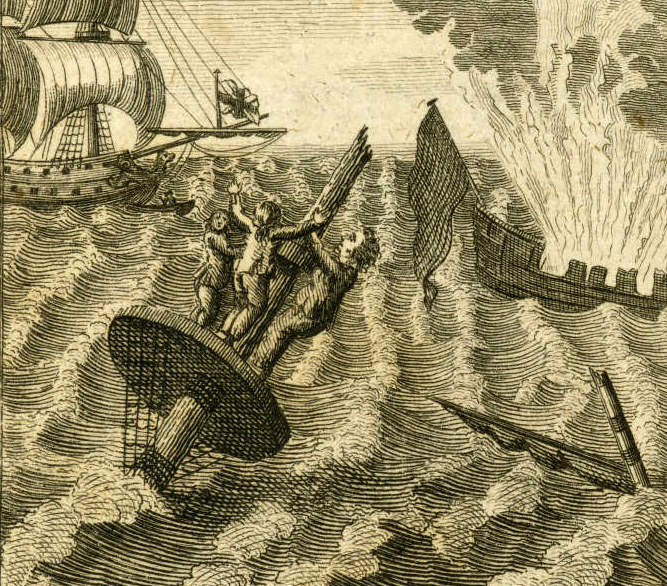BOOK REVIEW: Washington’s Marines: The Origin of the Corps and the American Revolution, 1775-1777 by Jason Q. Bohm. (El Dorado Hills, CA: Savas Beatie, 2023) $34.95 hardcover
“In December [1776] he [Major Samuel Nicholas] was ordered to march with three companies of Marines to the Jerseys to be under his Excellency the Commander-in-Chief, and continue in the field until the men’s times of Inlistment expired.”—Journals of the Continental Congress, volume 21
 Reading congressional memoranda is hard business. Historians of the War for American Independence can be excused if they miss the import of those words. Even historians who specialize in the deeds United States Marine Corps have proceeded quickly on to later decades, or lingered only briefly with wistful remarks about the lack of details that prevent a writer from telling any story that might be there. But that dry statement found in the early records of the Continental Congress reveals a monumental change in the history of warfare and the history of America. American Marines were born from the British naval practices and traditions, and sea-soldiers are even older than the British (later Royal) Marines. Yet something happened in 1776 that changed everything for all Marines. That change was the deployment of Continental Marines to provide critical assistance to their Nation’s cause—on land, deep in the interior and away from the historic protection (and limitations) of the navy. Jason Bohm’s recent book, Washington’s Marines: The Origin of the Corps and the American Revolution, 1775-1777 allows novice and specialist alike a chance to appreciate the significance of that moment.
Reading congressional memoranda is hard business. Historians of the War for American Independence can be excused if they miss the import of those words. Even historians who specialize in the deeds United States Marine Corps have proceeded quickly on to later decades, or lingered only briefly with wistful remarks about the lack of details that prevent a writer from telling any story that might be there. But that dry statement found in the early records of the Continental Congress reveals a monumental change in the history of warfare and the history of America. American Marines were born from the British naval practices and traditions, and sea-soldiers are even older than the British (later Royal) Marines. Yet something happened in 1776 that changed everything for all Marines. That change was the deployment of Continental Marines to provide critical assistance to their Nation’s cause—on land, deep in the interior and away from the historic protection (and limitations) of the navy. Jason Bohm’s recent book, Washington’s Marines: The Origin of the Corps and the American Revolution, 1775-1777 allows novice and specialist alike a chance to appreciate the significance of that moment.
The recently retired Brig. Gen. Jason Q. Bohm may be known to readers from his previous book From the Cold War to Isil: One Marine’s Journey (Naval Institute Press), or perhaps from his leadership within the Marine Corps and NATO. Bohm’s professional career has given him both practical and political experience—Bohm rose steadily from platoon commander to many high-ranking offices with the Marines, such as a strategic planner with NATO and with the Joint Chiefs of Staff, as the Director of the U.S.M.C. Expeditionary Warfare School, or as the House Director of the Marine Corps Office of Legislative Affairs—all of which lend themselves to the study of military history, and in particular to understanding the role and demands of leadership. Bohm understands that warfighting takes place always in a complex context. Only in understanding the context can one understand the particulars of any circumstance. Bohm allows himself to linger and explore the fragmented early records and elusive details from the first years of the American Revolution. In so doing, he breathes life into that bald Congressional record. Sometimes it takes a quarter of a millennium to remember and celebrate rightly.
The bulk of Bohm’s work covers a period of less than two years from the autumn of 1775 to the late summer of 1777 with appropriate background and epilogue material. In a particular way, Bohm presents his book as a work which provides historical focus to then Lt. Gen. Victor Krulak’s answer to the question (in 1957)—“Why does the U.S. need a Marine Corps?” The question had been posed by the then-Commandant of Marine Corps, Gen. Randolph Pate. Krulak replied that America did not “need” a Marine Corps, but it “wanted” one. It wanted men of honor and excellence; it wanted a military force that was flexible, poised for action, and determined. Washington’s Marines is an exploration of the origins, not simply of American Marines in the eighteenth century, but an exploration of the spirit and the structural character of the Corps. Bohm is wrestling with his own experiences of “sea-soldiers,” whose recent history seems no longer punctuated, but rather dominated by land warfare. Bohm’s narrative presents to students, historians, modern officers, and military analysts an important fact: It is not a matter of recent development (and not uncharacteristic deviation) to have the Marines deployed for land campaigns, it is a trait stamped into the genetic structure of the Marines from their earliest years. If America and her civil officers (especially the President) call for it, the Marines must respond positively to a land-based assignment. In the eighteenth century, extended campaigning on land “was a new concept to Marines, as they were not trained for prolonged land campaigns or operating onshore beyond the support of naval guns” (page 3). With the birth of the American Marines military practice developed significantly in a way Bohm allows us to appreciate.
Recalling the first years of the Continental and State Marines is certainly not unknown in the earlier histories of the Marine Corps, but the interpretive emphasis was long lacking, an emphasis on how important those earliest years were—especially those critical weeks described by Thomas Paine (in The American Crisis) as “the times which try men’s souls,” from September 1776 to February 1777, the heart of which was the New Jersey campaign and the battles around Trenton and Princeton. Capt. Richard S. Collum’s History of the United States Marine Corps (1890) spoke nothing of them, instead dedicating space to a description of the emergent Marine uniform. Over half a century later, Charles Lee Lewis’s Famous American Marines (1950) gave the event a single long paragraph in his chapter on Samuel Nichols. Pierce and Hough’s The Compact History of the United States Marine Corps (1960), gave the events several paragraphs, but the Marines’ participation in the campaign is described baldly as the result of Washington “scraping the bottom of the manpower barrel.” Brig. Gen. Edwin H. Simmons’ The United States Marines: The First Two Hundred Years, 1775-1976 (1976) expanded coverage to a full page which, by the third edition, grew to several, but he drew no significance from the campaign. It is true, Lt. Col. Clyde Metcalf, in his A History of the United States Marine Corps (1939) had dedicated a portion of his first chapter to the support the Marines gave to Washington’s land force, and he covered all the essential events mentioned by Bohm, but again, the significance of the contribution was not highlighted. Finally, the now standard Semper Fidelis by Allan R. Millet contains the episode in two pages and only hints at significance: “For the first time American Marines marched off to bolster an American Army.”
Even in that jewel of Marine historiography, Charles R. Smith’s Marines in the Revolution: A History of the Continental Marines in the American Revolution, 1775-1783 (1975), a positive significance to the Trenton-Princeton campaign is missing and, indeed, the assessment moves in a direction contrary to Bohm’s. Concluding his section on those events, which saw Maj. Samuel Nicholas’s “battalion” of Marines placed into the field for months, Smith wrote, “The incorporation of Nicholas’s three companies into the army had the superficial effect of dispersing both Marine talent and personnel, but far beyond this, the action crushed the idea of an independent corps of Marines, finally reducing them to a series of ship’s detachments. The New Jersey campaign of 1776-1777 had a similar effect on Major Samuel Nicholas, who no longer functioned as the head of the Marines but remained essentially a high-ranking officer without an assignment” (Marines in the Revolution, p. 105). For Bohm, on the other hand, these years are a tale of Marines at their best—serving “a critical role in the American Revolution. Rushing to the aid of George Washington and the Continental Army in their most desperate hour, their actions helped turn the tide of the war … In doing so, they established a legacy that generations of Marines strive to emulate to defend their great nation” (Bohm, Washington’s Marines, p. 298). Bohm’s chief and lasting contribution will be this clear emphasis on how characteristics which would become pronounced later (viz., land campaigning, rapidity in deployment, etc.) were already evident in the embryonic Corps of 1770s.
The Prologue (p. x-xiv) sets out the major themes of the book, providing the whole work in summary form, and ends with Bohm’s concern that the distance between modern readers and the American Founding may obscure the “sacrifice, dedication, and perseverance required” to maintain our freedoms. Chapter 1—“Enter the Marines” retells the 1775 formation of the Marines by the Continental Congress—an action, Bohm and others proudly point out, that makes the Marines older than the country they serve. The chapter covers well-known ground—Tun Tavern, the centrality of Philadelphia to the birth of the Corps, etc.—but also reminds readers that the idea of sea-solder stretches back to antiquity and the American Marines were heirs to long tactical use of such specialized forces. Chapter 2—“The Path to Rebellion” takes the reader back to the mid-eighteenth century, rehearses the effects of the French and Indian Wars on the British Empire, and traces the disintegration of the political bonds between Britain and America, ending with the formation of the Continental Army, Navy, and Marines in the months after Lexington and Concord. Chapter 3—“A Humble Beginning” narrates the major events of 1775 with an eye to how the circumstances of the war demanded the formation of a Marine Corps: The United Colonies constituted a maritime confederation at war with a naval superpower. The Marines were part of this new nation’s destiny. Washington and Congress were vexed at the near impossibility of winning, or even envisioning, a successful naval campaign, but the absolute necessity of pursuing a favorable land war demanded the guarding of select logistical sites on the seas, rivers, and the great lakes. Washington himself, though reluctant to divert resources into sea power, outpaced Congress in forming a small navy of his own initiative during the Siege of Boston. Skeptics of placing resources into the Marines were pleased at the first fruits of the Corps. In Chapter 4—“Early Victories,” the greatest of these efforts, the March 1776 raid on New Providence Island is at the center. Often lauded for being the Corps’ first amphibious landing, the greater significance is brought out well by Bohm: The war was taken to the British beyond North America and began to shift public opinion about the winning odds of the patriots.
Two chapters, 5—“A Growing Crisis” and 6—“The Pursuit Across New Jersey describe the nadir of the War for Independence: Gen. William Howe’s near constant besting of Washington, the dwindling away of militia and Continentals, and the weeks of dreary decline forestalled more by British restraint springing from a hope that the core of loyal colonists would return to the folds of Empire. The small role of the Marines during this period matched their size—several hundred in three to four companies, serving on a handful of small ships and concentrated chiefly on protecting Philadelphia while the new Navy was slowly being constructed, frigate by frigate. The panic of December 1776 put an end to such duties; Congress ordered the Marines to assist the Army, and Washington combined them with unique a military unit called the Philadelphia Associators, the most democratic of all American militia, under the command of Brig. Gen. John Cadwalader.
The four later chapters are of a piece. Chapter 7—“Seizing the Initiative,”, Chapter 8—“Victory or Death,”, Chapter 9—Going for Broke,” and Chapter 10—“An Unexpected Battle” bring the reader to the heart of the matter. What did the first Marines face while campaigning; how were they deployed and supplied; what was their morale; were they effective in combat; and ultimately, what was their fate. These chapters place the Marines in the context of Washington’s remarkable “ten crucial days”—which stretched from December 25, 1776 to January 3, 1777. Those days saw the military forces of the American patriots on the verge of collapse, with enlistments rushing to their termination like a flaming fuse towards an explosion. In those days lay the fate of the young United States. In those days, when desertion compounded the faint numbers of an anemic army, small, but arguably vital assistance was provided by the Marines; so Bohm writes. Intelligence gathering, securing critical junctions and logistical centers, and most especially at the battles of Second Trenton and Princeton, the Marines stood in the breach when there was no one else to call upon. Bohm’s Epilogue bounds through some salient moments in the subsequent early years of the Corps and lands with a rhetorical meditation of the soul of the Corps—it must remain itself, flexible, elite, innovative, and bold, so that it can fulfil its mission to the Nation: semper fidelis.
The book ends with two appendices (the Birthday Message by Gen. John Lejeune and Washington’s “Orders to Col. John Cadwalader, 12 December 1776”—the first near example of an executive’s summons to the Marines to assist in a land campaign), as well as an extensive bibliography and index.
The three strengths of Bohm’s work are synthetic power, the author’s authoritative military experience, and an engaging narrative style. In the face of limited evidence and early source material, it is little surprise that Bohm rarely introduces new material, archival finds, etc. However, he recalls and humbly reassembles forgotten secondary sources. Nineteenth-century local histories are very adroitly used—something at which modern scholars often turn up their noses—and even idiosyncratic (but rich) works like the books of Catholic historian Martin Griffin make appropriate appearances. Bohm stays largely close to a handful of sources, both primary and secondary. The works of John Ferling are favored, and Middlekauf’s The Glorious Cause provides a reliable framework for Bohm’s entire narrative. David Hackett Fisher’s Washington’s Crossing and the older The Battles of Trenton and Princeton (1898) by William Stryker provide consistent guidance to his interpretation of the events and the structure of his retelling. Bohm steadily cites from the established collections like the massive and venerable anthology Spirit of 1776 by Henry Steele Commager and Richard B. Morris (1958-1990), a clear favorite of Bohm. Readers who have not put in time reading the classics of the Marine Corps Doctrinal Publications may not notice Bohm’s deft use of technical military language; scholars will certainly benefit by considering Bohm’s recurring use of technical language through the work. Bohm rightly plays to his strengths in his analysis of campaigning, logistics, tactics, the use of intelligence, etc. He has said and written elsewhere that MCDP 1 Warfighting is one of his guiding stars. It shows. This combination of a judicious use of standard works, sparing and humble deployment of the primary sources already gathered by others, and comfortable reliance on his own professional experience as Marine, leads to an engaging read. All three strengths show best in his assessment of George Washington. In many respects, this book is as much a study of Washington as the of the Marines, and Bohm brings decades of firsthand experience to an interior understanding of the pressures and choices facing Washington in those dark years of the War.
The book’s weaknesses are collateral to its strengths. Bohm’s powers of synthesis come from reducing a mass of secondary literature, but the danger is that the grand scope of the work leaves little room for detail or discovery. Consistent with the author’s objective of reframing well-known material, Washington’s Marines presents very little, perhaps nothing factually new on the Marines themselves that is not already present in Smith’s Marines in the Revolution. In fact, absent from the book is much of the detail and careful source reading that made Smith’s work a breakthrough study. Certain, important historiographic developments are missing or understated in Bohm’s narrative: For example, with his treatment of the Howe brothers or the British Whigs, so sympathetic to the patriotic cause or, more egregiously, in his sharp division of the sides of the conflict into British versus Americans, with Loyalist left as essentially non-American colonists, Bohm finds himself outside of decades of research on the early years of the war. At the very least, works like H.W. Brand’s Our First Civil War (2022) or Tom Allen’s Tories (2011) would have allowed the book to offer readers a clearer view of the terrain and knowledge of the resources available, especially for those studying the early years of the conflict.
Those keen on exploring Bohm’s topic may wish to augment his bibliography. The secondary literature on the navy is surprisingly light, readers would benefit from Sam Willis’s The Struggle for Sea Power: A Naval History of the American Revolution (2016) and its bibliography. Similarly, anything by John Shy, or Charles Royster’s A Revolutionary People at War (1979) will give even greater depth to Bohm’s analysis and add some social history as well. Battles of the Revolutionary War by twenty-three-year Army artillery veteran W.J. Wood would have been a good ally. One of the largest gaps comes from the book’s not fully incorporating British perspectives or leaving out critical works on British strategy. Perhaps a second edition of the book will bring to bear Piers Mackesy, The War for American, 1775-1783 (1964), Stanley Carpenter (ed.), The War of American Independence, 1763-1783 (2023), and especially Andrew Jackson O’Shaughnessy’s The Men Who Lost America: British Leadership, the American Revolution, and the Fate of Empire (2013). If nothing else, these would provide a way of better assessing the strategic and tactical judgements of the players in Bohm’s story. But there is no end of scholarship, and generally all must applaud Bohm for traveling light and keeping up the tempo of his tale. Ironically, however, the sweeping contextualization of Bohm sometimes leaves the Marines missing from his grand tapestry. Readers will be frustrated in hitting upon sentences that open with such words as “Unfortunately no records exist of the interactions between the Marines and…” or “Unfortunately no records exist of Major Nicholas and his Continental Marines actions at this point…” (p. 266 and 277). No historian can transcend the limitation of his source material. Finally, the bibliography is idiosyncratic in its organization; it breaks up material into so many separate sections and subsections—online works, periodicals, books, public documents, and dissertations and theses—that it can be difficult at times to use the work as a reference or trace down a source from a footnote.
None of the limitations, nor all of them combined, however, should dissuade readers from turning to Bohm’s work. Generalists, specialists, and those in the military and civil government alike will all benefit from this work. The emphasis Washington’s Marines places on the earliest years as crucial for establishing the character of the Corps will remain a lasting contribution as the scholarship on this subject continues to grow.
PLEASE CONSIDER PURCHASING THIS BOOK FROM AMAZON IN HARDCOVER OR KINDLE.
(As an Amazon Associate, JAR earns from qualifying purchases. This helps toward providing our content free of charge.)








3 Comments
Jason Bohm served as and retired as a Major General in the USMC, not a BG.
Dear Mr. Venter,
Thank you for the correction. I am not sure how I made the error, but I am grateful for the catch.
WEF
Excellent review–thoughtful, knowledgeable, well written and informative.